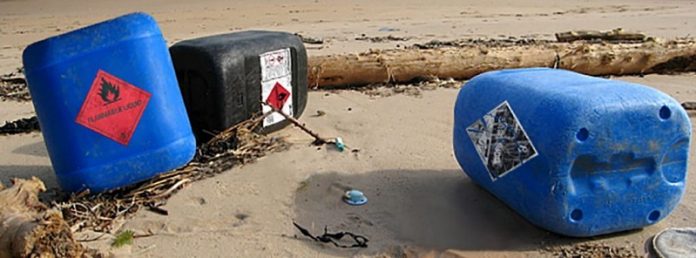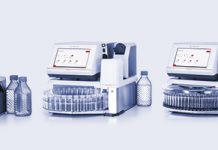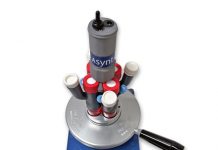When chemical manufacturers transport dangerous goods by sea, they are subject to stringent safety regulations and the labels that they apply to their containers are required to comply with the IMDG Code. The BS5609 labels standard helps to ensure that the label on any drum washed overboard will still be stuck to the container, and be legible, after 3 months in seawater.
The term BS5609 label is usually applied to labels that are extra durable in regard to weathering, fading in UV light, and abrasion.
It is not an imperative requirement for dangerous goods labels to have BS5609 certification – unless it is a printed self-adhesive label placed on a chemical drum and shipped by sea. However, this standard has become a quality benchmark for labels in the chemical and hazardous goods industries.
THE IMDG CODE
The International Maritime Dangerous Goods Code (IMDG Code), is an accepted international guideline for the safe transportation of dangerous goods or hazardous materials by water. The IMDG Code aims to protect the members of a ship’s crew and also aims to to prevent marine pollution by ensuring that any dangerous substances are stored and labelled in a correct manner. It does not specify any tests for labels – only a durability requirement, and It states that a label must withstand 3 months immersion in sea water and that in both supply and conveyance the label must be permanently adhered to the container and the text must remain legible – and this is where BS5609 comes into play.
BS5609 LABELS
Because these labels need to remain legible and adhere to the container in the event of being washed overboard, British Standards were asked to create a document detailing requirements and suitable testing procedures, which, when followed, would produce a label which would perform to the necessary level. BS5609 (also known as the ‘Marine Immersion Labels Testing Standard’) provides outlines for these tests and requirements for ‘durability’ and goes further to include all labels and markings required for movement by sea. However, in reality BS5609 is not a legal requirement; it is more a standard to work to which will ensure that self adhesive drum labels used to identify dangerous goods that are transported by sea perform adequately, but as yet, it has never been extended into an ISO standard.
The IMDG Regulations (which are created by the IMO) states that: “Packages and Cargo transport Units containing dangerous goods are to be durably marked for carriage by sea. “Durably marked” means that the label, or other marking, is such as to remain identifiable on packages surviving at least three months immersion in the sea. The durability requirements for pressure sensitive labels can be achieved through British Standard, BS5609 : 1986 (British Standard Specification for Printed Pressure Sensitive, Adhesive-coated Labels for Marine Use, including Requirements for Label Base Material), which was published in December 1986.”
The BS5609 certification is a four part certification for both the label material and the printed information on the label. Both elements must be tested successfully, as evidenced by separate certifications, for a label to achieve the BS5609 certification.
The two key sections of the standard are:
BS5609 SECTION 2 COMPLIANCE
Section 2 tests are conducted on the blank adhesive coated base material. Testing procedures include exposure to artificial weathering (salt spray and sunlight) and dimensional stability and adhesion. When a label is Section 2 compliant, it means that only the blank label is BS5609 Section 2 compliant.
BS5609 SECTION 3 COMPLIANCE
In Section 3 it is the printed label that is tested, whereas Section 2 only tests the blank label stock. With Section 3 compliance, labels are tested for abrasion resistance and permanence of print. Tests include exposure to artificial weathering, tape removal and abrasion resistance.
Section 3 tests can only be made on base labels that have already met the requirements of Section 2.
ARE HIBISCUS LABELLING MATERIALS BS5609 COMPLIANT?
Firstly, there are plenty of companies who offer “BS5609 labels”, but you must be cautious because there are potential pitfalls. Label adhesion in the BS5609 standard is based on adhesion to aluminium plates under laboratory conditions, but very few companies actually send their goods out in pristine aluminium packaging! A label which adheres very well to an aluminium plate may not survive more than a few hours on a different surface like a plastic drum, and it is the responsibility of the shipper to ensure that the packages are labelled satisfactorily.
BS5609 does recommend additional testing of any potential label to ensure that it is appropriate for the surface you are using, and since testing is so easily done, we would recommend trials if you are not sure. Secondly, BS5609 is in four parts. Parts 2 and 3, as mentioned, are concerned with the base label and print (including overprint). If your label supplier confirms that the label complies with BS5609 – do they mean the whole label ie: label, pre-print and overprint? More likely, it’s just the base material which has been tested for 3 months immersion in sea water.
Hibiscus Plc can supply Section 2 compliant labels for most applications and environments (including hot fill and cold storage). Our matt white PE material is available for all of our sheet label ranges and is commonly used in harsh and difficult labelling environments due to its excellent technical attributes. Section 3, though, is a much greyer area…
SECTION 3 TESTING
Hibiscus Plc is one of only a handful of label printers in the UK that actually perform their own Section 3 tests, and if we print labels using our own tested substrates and inks, then we can provide fully compliant BS5609 labels.
However, when asked if we can supply BS5609 compliant printers and consumables, then we can only advise that we can provide printers, ribbons and blank labels which are capable of achieving compliance, but this depends upon an appropriate amalgamation between the label substrate, the ink applied, and the printer used to apply the ink. For example, thermal printer ribbons are available in several ink formulations to suit both the head technology of the printer with which they are destined to be used and the surface grip of the material they are designed to print on. Consequently, a ribbon which achieves BS5609 standard performance on a particular substrate when printed by one printer may fail to do so when used in conjunction with a different substrate or printed by a different printer (even though the latter are themselves individually capable of compliance when using an appropriate ribbon).
Even where all other elements are the same, the actual setup of the printer (ie. head temperature) may itself have a marked effect. For these reasons, we cannot guarantee that any particular printer ribbon or toner is inherently BS5609 Section 3 compliant in itself – it depends upon how they are used and combined.
So, for complete compliance it is necessary to validate specific combinations of printer, ink and base label.
HIBISCUS PLC HAVE EXPERT KNOWLEDGE IN SUPPLYING LABELS, MATERIALS AND PRINTERS TO ENABLE COMPLIANCE ACROSS A DIVERSE RANGE OF INDUSTRIES.
If you have any questions about BS5609 labels, or require any further information about labelling, just contact us for details. Hibiscus Plc will be happy to guide you in the correct choice and usage of BS5609 printing materials to achieve appropriate results with our label products and we can even provide you with the basic tests for Section 3 compliance – Free of Charge!
CALL US TODAY: 0113 242 4272
ENQUIRIES@HIBISCUS-PLC.COM










